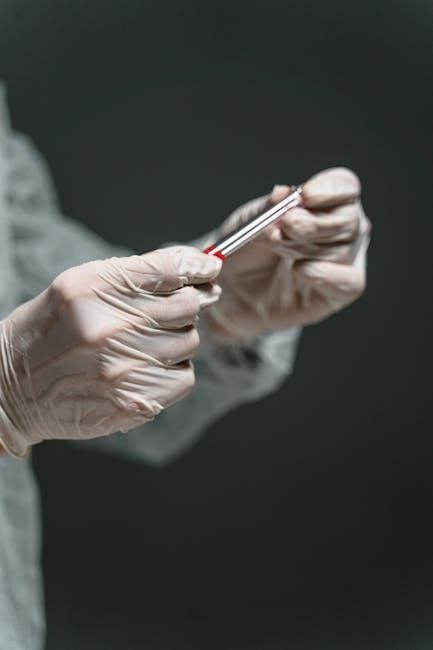
The top 200 drugs are essential medications frequently prescribed and studied in healthcare and pharmacy education. Mastering them is crucial for professionals and students alike, ensuring effective patient care and exam success.
1.1 Importance of the Top 200 Drugs in Healthcare
The top 200 drugs are cornerstone medications in healthcare, frequently prescribed for common conditions. They represent essential therapies across major categories, such as cardiovascular, antipsychotic, and antidiabetic agents. These drugs are critical for managing chronic diseases, improving patient outcomes, and reducing healthcare costs. Familiarity with these medications ensures healthcare professionals deliver safe and effective care. They also serve as a foundation for understanding pharmacotherapy, enabling better decision-making. Knowing these drugs is vital for clinicians to address prevalent health issues efficiently and appropriately.
1.2 Role of the Top 200 Drugs in Pharmacy Exams
The top 200 drugs are a cornerstone of pharmacy exams, such as the PTCB and NAPLEX, as they represent the most commonly prescribed medications. Mastery of these drugs is essential for exam success, as they frequently appear in questions. Students must know their generic and brand names, therapeutic classes, indications, and dosages. Study guides, flashcards, and practice quizzes are widely recommended to aid memorization. Understanding these drugs ensures competence in pharmacy practice and prepares professionals for real-world scenarios. They are a critical focus for anyone aiming to excel in pharmacy certification exams and deliver effective patient care.

Drug Classification System
The drug classification system organizes medications by therapeutic purpose, mechanism, or chemical structure, aiding in study and application. It simplifies learning and clinical decision-making, ensuring accurate drug use.
2.1 Overview of Major Therapeutic Categories
Major therapeutic categories group drugs by their primary use, such as cardiovascular, antipsychotic, antidiabetic, and antibiotics. These categories help in understanding drug functions and target conditions, enhancing learning efficiency and clinical application. Each category addresses specific health needs, making it easier to associate drugs with their uses and side effects. This structured approach is vital for both healthcare professionals and students, ensuring accurate prescribing and patient care.
2.2 Cardiovascular Drugs
Cardiovascular drugs are crucial for managing heart-related conditions like hypertension, heart failure, and high cholesterol. Common medications include ACE inhibitors (e.g., Lisinopril), beta-blockers (e.g., Metoprolol), and statins (e.g., Atorvastatin). These drugs help regulate blood pressure, reduce cardiac workload, and lower cholesterol levels. They are among the most prescribed and studied in the top 200 list. Understanding their mechanisms and side effects is vital for effective patient care. Students often focus on associating drugs with their classes and primary uses to enhance memorization and application in clinical settings.
2.3 Antipsychotic Drugs
Antipsychotic drugs are primarily used to treat mental health conditions like schizophrenia and bipolar disorder. They help manage symptoms such as hallucinations and delusions. Common examples include Clozaril (clozapine) and Risperdal (risperidone). These medications are categorized into first-generation (typical) and second-generation (atypical) drugs, with the latter often having fewer side effects. Understanding their pharmacological effects and side profiles is essential for healthcare professionals. Antipsychotics are frequently included in the top 200 drugs due to their high prescription rates and clinical significance in mental health treatment.
2.4 Antidiabetic Drugs
Antidiabetic drugs are crucial for managing diabetes, particularly type 2 diabetes. Common medications include Glucophage (metformin), a first-line treatment, and Januvia (sitagliptin), which regulate blood sugar levels. These drugs work by enhancing insulin sensitivity or reducing glucose production. Other notable drugs like Trulicity (dulaglutide) and Ozempic (semaglutide) are GLP-1 receptor agonists, offering additional benefits for weight management. Familiarizing yourself with these medications is vital for patient care, as they are among the top 200 prescribed drugs due to the prevalence of diabetes worldwide.
2.5 Antibiotics
Antibiotics are vital for treating bacterial infections and are among the most commonly prescribed medications. They are categorized into classes like penicillins, cephalosporins, macrolides, and fluoroquinolones. Examples include amoxicillin, azithromycin, and ciprofloxacin. These drugs target bacterial cell walls or protein synthesis to inhibit growth. Understanding their spectra of activity, dosages, and potential side effects is crucial. Antibiotics like Bactrim (trimethoprim/sulfamethoxazole) are used for urinary tract infections, while others, such as doxycycline, treat conditions like acne. Proper prescribing practices and awareness of resistance patterns are essential for effective treatment and patient safety.
Generic vs. Brand Name Drugs
Generic drugs are cost-effective alternatives to brand name medications, offering the same active ingredients and therapeutic effects at a lower price, approved by the FDA.
3.1 Key Differences Between Generic and Brand Name Drugs
Generic and brand name drugs differ primarily in name, price, and marketing. Generics are significantly cheaper due to lower development costs and lack of patent exclusivity. They must meet the same FDA standards as brand drugs, ensuring identical active ingredients and therapeutic effects. Brand drugs, developed by pharmaceutical companies, are often more expensive because of research and marketing expenses. Despite these differences, generics provide equal efficacy and safety, making them a cost-effective alternative for patients and healthcare systems. This distinction is crucial for students and professionals studying the top 200 drugs.
3.2 Examples of Generic and Brand Name Equivalents
Generic drugs are bioequivalent to their brand-name counterparts, differing only in name and price. For instance, Metformin (generic) is equivalent to Glucophage (brand) for diabetes, while Lisinopril (generic) matches Zestril (brand) for hypertension. Similarly, Clozapine (generic) is the equivalent of Clozaril (brand) for schizophrenia. These generics contain the same active ingredients and meet FDA standards, offering cost-effective alternatives. Understanding these equivalencies is vital for healthcare professionals and students, aiding in cost-effective prescribing and patient education. This knowledge is a cornerstone of the top 200 drugs study guide.

Pharmacological Uses and Indications
The top 200 drugs are prescribed for common conditions like diabetes, hypertension, and schizophrenia. Understanding their primary uses and therapeutic benefits is key to effective patient care and study success.
4;1 Common Indications for the Top 200 Drugs
The top 200 drugs treat a wide range of conditions, including cardiovascular diseases, diabetes, infections, and mental health disorders. Many are prescribed for hypertension, hyperlipidemia, and type 2 diabetes, which are prevalent chronic conditions. Antibiotics like amoxicillin and azithromycin are commonly used for bacterial infections, while antipsychotics such as clozapine and risperidone manage schizophrenia. Understanding these indications helps in providing targeted therapy and improving patient outcomes. This knowledge is also vital for pharmacy students and technicians preparing for certification exams, ensuring they can identify appropriate medications for various diagnoses. Familiarizing oneself with these drugs enhances clinical decision-making and study efficiency.
4.2 Off-Label Uses of Popular Medications
Many top 200 drugs are used off-label for conditions not listed on their FDA-approved labels. For example, gabapentin, primarily for nerve pain, is often prescribed for migraines or anxiety. Similarly, amitriptyline, an antidepressant, is used off-label for chronic pain. These uses are supported by clinical evidence but require careful patient monitoring. Recognizing off-label indications enhances therapeutic options and improves patient outcomes. Understanding these uses is also crucial for pharmacy professionals, as it broadens their knowledge of drug applications and prepares them for real-world clinical scenarios and exam questions.

Tips for Effective Memorization
Organize drugs by class, use flashcards, and apply mnemonics. Engage with interactive tools and practice regularly to reinforce memory and master the top 200 drugs efficiently.
5.1 Breaking Down Drugs by Therapeutic Class
Organizing drugs by therapeutic class simplifies memorization. Grouping medications by their primary uses, such as antidiabetics or antihypertensives, helps link drugs to their indications. This method allows learners to associate similar mechanisms of action and side effects, enhancing retention. For example, understanding that metformin and glipizide both target blood sugar control but work differently streamlines study. Breaking drugs into categories like cardiovascular, antibiotics, or CNS agents reduces complexity. This approach also aids in clinical application, as recognizing drug classes helps predict effects and interactions in patient care scenarios. Consistent review of these groupings reinforces long-term memory and practical application skills.
5.2 Using Visual Aids and Mnemonics
Visual aids like charts, diagrams, and flashcards enhance memorization by making complex information more engaging. Mnemonics, such as acronyms or rhymes, help associate drug names with their uses or classes. For example, creating mind maps or using color-coded lists can visually group drugs by category. Techniques like linking drug names to memorable images or phrases improve retention. Mnemonics also help differentiate similar-sounding drugs, reducing confusion. Incorporating these tools into study routines makes learning the top 200 drugs more efficient and enjoyable, ensuring better recall during exams and real-world applications.
5;3 Gamification and Interactive Learning Tools
Gamification transforms drug study into engaging activities, boosting motivation and retention. Interactive tools like quizzes, puzzles, and apps offer hands-on learning experiences. Platforms such as Quizlet provide flashcards, games, and tests that simplify memorization. Apps like Pharmacy Technician Exam Prep feature multiple-choice questions and progress tracking. These tools make studying dynamic and fun, helping users master the top 200 drugs through friendly competition and real-time feedback. Gamification not only enhances learning but also reduces study fatigue, making the process more enjoyable and effective for long-term retention.

Study Resources and Tools
- Flashcards and study guides provide concise drug information.
- Mnemonics and memory aids enhance retention.
- Practice exams and quizzes test knowledge.
- Mobile apps offer interactive learning.
6.1 Flashcards and Study Guides
Flashcards are a popular tool for memorizing the top 200 drugs, offering concise information like generic and brand names, drug classes, and indications. Many students use digital flashcard apps, which allow quick access and self-testing. Study guides complement flashcards by providing detailed explanations and structured learning; They often include drug classifications, mechanisms of action, and common side effects. These resources are particularly useful for pharmacy technician certification exams, helping learners focus on key points efficiently. Combining flashcards with study guides creates a robust study system for mastering essential medications.
6.2 Mnemonics and Memory Aids
Mnemonics and memory aids are powerful tools for remembering the top 200 drugs. Techniques like acronyms, rhymes, and associations help learners connect drug names with their uses or classes. For example, creating a sentence where each word represents a drug’s initial can enhance retention. Visual mnemonics, such as diagrams or mind maps, also aid in organizing information. These methods make complex drug details more manageable, especially during exam preparation. By using mnemonics, students can reduce study time and improve recall accuracy, ensuring better performance in pharmacy exams and real-world applications.
6.3 Practice Exams and Quizzes
Practice exams and quizzes are invaluable tools for mastering the top 200 drugs. They simulate real exam conditions, helping users assess their knowledge and identify gaps. Platforms like Quizlet and PTCB practice tests offer interactive questions, enabling learners to test their understanding of drug names, classes, and uses. Regular quizzes enhance retention and improve time management skills, crucial for exam success. By repeatedly applying knowledge in a test-like format, students build confidence and familiarity with the material, ensuring they are well-prepared for certification exams and clinical applications.
6.4 Mobile Apps for Drug Study
Mobile apps are powerful tools for studying the top 200 drugs, offering convenience and accessibility. Apps like Quizlet, ClinCalc DrugStats, and Nursing Drug Guide provide interactive flashcards, practice exams, and comprehensive drug databases. These platforms enable users to memorize drug names, classifications, and uses on-the-go; Many apps feature gamification, quizzes, and real-time progress tracking, making learning engaging. Additionally, apps like Pharmacy Tech Exam Prep offer focused practice for certification tests. By leveraging these digital resources, students and professionals can enhance their knowledge efficiently, ensuring mastery of the top 200 drugs anytime, anywhere.




